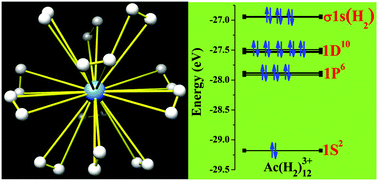Predicted M(H2)12n+ (M = Ac, Th, Pa, U, La and n = 3, 4) complexes with twenty-four hydrogen atoms bound to the metal ion†
Abstract
Herein, we have shown that La(III), Ac(III), Th(III), Th(IV), Pa(IV) and U(IV) can directly bind with a maximum of 24 hydrogen atoms in M(H2)12 in the first sphere of coordination, which would be a new record in any metal–hydrogen complex investigated at the molecular level, where all the hydrogen atoms are directly connected to the central metal ion through M–η2(H2) bonds. Moreover, Ac(H2)n3+ (n = 9–12) systems satisfy the 18-electron rule.



 Please wait while we load your content...
Please wait while we load your content...